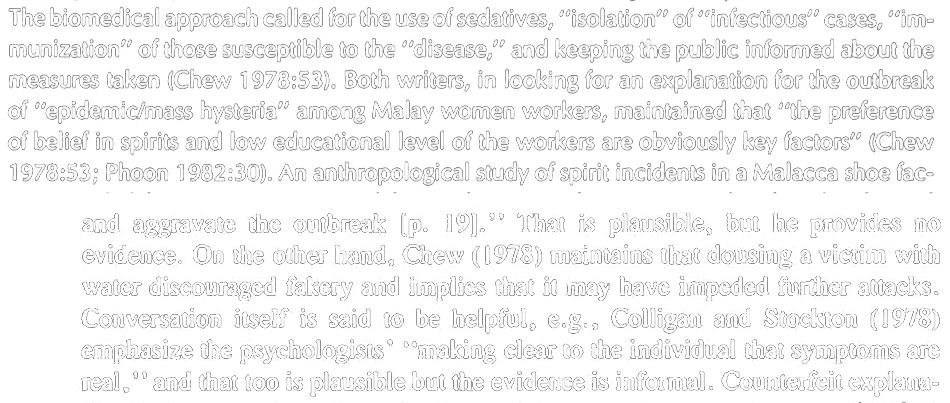How to handle hysterical factory workers
In a bid to prevent more incidents of MPI from taking place in factories, an article was written in 1978 titled How to handle hysterical factory workers. This article was never published in the Singapore Medical Journal. I could not locate the article but I was aware that it exists from seeing it cited in other sources. This gave me the idea to reconstruct the article with citations found from other publications and articles. Here is my effort presented below.









In relation to the topic of the article, I found other strategies that were employed to deal with affected cases.This comes from one of the medical articles, Epidemic Hysteria Among Some Factory Workers in Singapore which was co-authored by W. H. Phoon and H. A. Mae-Lim and P.K. Chew in 1976.

In an oral history interview that is stored in the National Archives of Singapore, Dr Hia Kwee Yang who was also involved with the case comments giving affected individuals two weeks of unpaid medical leave was effective in curbing further incidents from happening. He was also quite adamant that some non affected workers initially “piggybacked” on those who were affected to be able to take time off from work.
Another article written by Timothy F. Jones provides clear steps to treat these episodes. Thankfully, splashing water on the affected is no longer one of the steps.
Recommended Approach to Patients with Mass Psychogenic Illness:
-
Attempt to separate persons with illness associated with the outbreak.
-
Promptly perform physical examination and basic laboratory testing sufficient to exclude serious acute illness. -Monitor and provide oxygen as necessary for hyperventilation.
-
Minimize unnecessary exposure to medical procedures, emergency personnel, media or other potential anxiety-stimulating situations.
-
Notify public health authorities of an apparent outbreak.
-
Openly communicate with physicians caring for other patients.
-
Promptly communicate results of laboratory and environmental testing to patients.
-
While maintaining confidentiality, explain that other people are experiencing similar symptoms and improving without complications.
-
Remind patients that rumors and reports of ”suspected causes” are not equivalent to confirmed results.
-
Acknowledge that symptoms experienced by the patient are real.
-
Explain potential contribution of anxiety to the patient's symptoms.
-
Reassure patient that long-term sequelae from current illness are not expected.
- As appropriate, reassure the patient that thorough clinical, epidemiologic and environmental investigations have identified no toxic cause for the outbreak or reason for further concern.1
Timothy F. Jones goes on to further describe certain dilemmas that the physician might face, especially the potential issue of “testing”.
“Physicians are trained to search for an organic cause of disease, and it can be very difficult to resist pressure to perform increasingly obscure tests in search of an elusive diagnosis, particularly amid the substantial public concern frequently generated by such outbreaks.”2
“The well-known adage, “If you order enough tests, something will come back abnormal,” can leave a physician having to explain an abnormal result to a patient who has symptoms that may be completely unrelated to that parameter.”3
He defines what the main objective should be and reiterates the fact that prompt actions have to be taken to prevent the prolonging of issues caused by the incidents of MPI. This point is also supported by Dr Hia Hwee Yang who decisively gave workers two weeks of unpaid leave. The number of cases supposedly went down afterwards.
“In approaching mass psychogenic illness, the goal should be to restore individual persons and the community to routine function as quickly as possible.”4
“In any approach to mass psychogenic illness, a prompt, coordinated response is important in resolving widespread community anxiety surrounding these episodes.”5
He also mentions how prompt identification and labelling of an incident as MPI can be hard to put into practice.
“Labeling an outbreak as psychogenic may minimize unnecessary testing and halt spread, but the perception of a less than thorough investigation can lead to mistrust and anger.”6
“Another strategy involves reassuring patients while avoiding naming the illness. This approach does not provide a “diagnosis,” and the absence of an identified source may lead to continued concern, symptom spread and increased testing.”7
Ultimately, he also suggests garnering support from colleagues to help with the diagnosis.
“Physicians should discuss the diagnosis of mass psychogenic illness with colleagues to garner support for subsequent actions.”8
Robert E. Bartholomew and M. Chadra Sekaran Muniratham argue against the use of the term “hysteria” when addressing the media to avoid causing distress to the affected individuals.
“When addressing the media, it is imperative that mental health professionals avoid the use of the word “hysteria” as it is likely to engender defensiveness on the part of patients and relatives who often react with anger and hostility.“9
They also warn of the dangers of speculation.
“Because such speculation often leads to more outbreaks, it is important for spokespersons to remain on message and refrain from speculation to the existence of such agents. It is important not to rely on early media reports because they are often inaccurate.”10
1-8. Jones, Timothy F. “Mass Psychogenic Illness: Role of the Individual Physician.” PubMed, vol. 62, no. 12, Dec. 2000.
9-10. Bartholomew, Robert E., and M. Chandra Sekaran Muniratnam. “How Should Mental Health Professionals Respond to Outbreaks of Mass Psychogenic Illness?” Journal of Cognitive Psychotherapy, vol. 25, no. 4, 2011.
